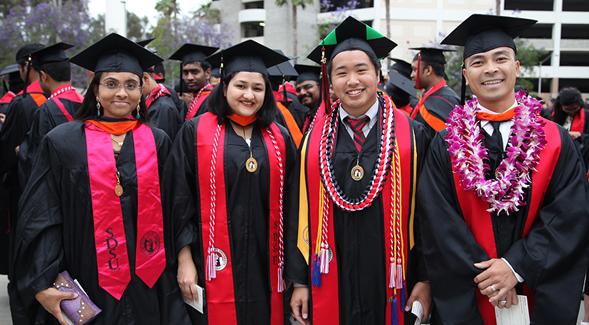Tips for Job-Seeking Graduates
SDSUs executive director of Career Services provides tips for graduates heading into the job market.

This year, San Diego State University will send nearly 10,600 graduates into the workforce.
According to James Tarbox, executive director of SDSU’s Career Services, the job market for the class of 2018 continues to look strong for those students who are prepared.
The National Association of Colleges and Employers (NACE) reports a slight 1.3 percent dip in employer recruiting of college graduates when compared to the class of 2017. This is the first dip in college recruiting reported by the association since 2010.
So what do this year’s SDSU graduates need to do to be at the top of recruiters’ lists? Tarbox offers three useful tips for job searchers:
1. Commit to your job search
The job search itself is a job—it requires time, concentration and an ongoing assessment of what works and what needs to change to be more effective.
First, dedicate your time to understanding where you want to live and what industries that region’s market supports. That is, does a job market exist for the type of jobs that you seek? To learn about a region’s industries, start with regional business journals, chambers of commerce and active professional associations.
Second, ask yourself how long (e.g., three months) you intend to conduct your job search.
Third, with a realistic assessment of the job market and your timeline, dedicate time getting your job search toolkit in place. Update your resume; research outlets for job postings, including popular sites such as Indeed; and identify opportunities for networking. Start with the SDSU Alumni App (and register for the monthly e-newsletter), look into professional associations (many student organizations have an equivalent professional association regional chapter), and then find out whether chambers of commerce have new professionals group (and if so, reach out to get involved).
Fourth, when needed, seek help. Plan on attending “Life After SDSU.” This is an alumni-focused workshop series that is provided by SDSU Career Services throughout the month of June. For four months post-graduation, SDSU graduates have access to Aztec Career Connection and the Career Resource Room. Also, all SDSU career fairs are free to SDSU alumni. The alumni e-newsletter and website provide links to register in advance.
2. Communicate your career readiness and strengths
First, assess yourself. NACE, in collaboration with universities and university recruiters, initiated a national effort in 2015 to help students be career-ready for the job market. NACE lists the eight core competencies of career readiness. Use these as a basis for communicating who you are and who you want to become as a professional.
Second, identify and own your knowledge, skills and abilities. That is, think about what tangible strengths you gained from internships, involvement in student organizations, part-time jobs, study abroad experiences, research and team projects. Further, own your strengths by being able to describe them and back them up with tangible examples. Document these experiences—text them to yourself, blog about them or make notes on your cell phone. Then, practice talking about them with a friend or family member. Your ability to communicate these strengths will be valuable as you complete resumes, cover letters, job applications, interviews and network with professionals.
3. Inventory and update your core transferable skills
As a student, you’re likely skilled in managing social media, in using connections to learn about events and opportunities, and in researching as a basis for learning. These are all skills that can be updated and transferred from your life as a college student to drive your success as a professional.
An effective way to transfer these skills is to inventory them. Ask yourself, for example, how am I using social media now? Then ask yourself, how would I need to change this use to support my job search? If you are using social media to stay updated about friends, then an easy transfer is to follow organizations where you might want to work. Similarly, if your profiles and feeds currently reflect how connected you are to your peers, adjust them to show how connected you are becoming to professional associations.
Finally...
Start your job search—apply for jobs, connect to professional associations and civic groups, and keep adjusting your approach as you follow your timeline. The job search cycle exists even in a strong economy where employers are actively seeing college graduates. Be sure to stay committed to applying for jobs and networking while interviewing. Interviews do not always lead to job offers, and unexpected events on the recruiting side can lead to search delays and rescinded offers. Keep your job search cycle active to manage job search setbacks.
Through it all, use your job search to learn, connect and grow.



